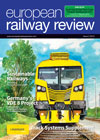Fourth Railway Package aims to foster growth
Posted: 2 April 2013 | | No comments yet
Ticketing technology supplier Amadeus has released a new study with an optimistic outlook for long-distance rail travel in Europe. The study estimates that long-distance passenger traffic will increase by 2.2% annually over the next seven years to reach over 1.36 billion by 2020 – 238 million up on 2011 figures. The continent’s three biggest economies, Germany, France and the UK, are the chief sources of the expected increase; also, affluent Switzerland is thought to have high growth potential.


Ticketing technology supplier Amadeus has released a new study with an optimistic outlook for long-distance rail travel in Europe. The study estimates that long-distance passenger traffic will increase by 2.2% annually over the next seven years to reach over 1.36 billion by 2020 – 238 million up on 2011 figures. The continent’s three biggest economies, Germany, France and the UK, are the chief sources of the expected increase; also, affluent Switzerland is thought to have high growth potential.
The report’s authors identified six factors that they thought would drive the increase: liberalisation; new market entrants; completion of new high-speed lines; new hubs; air-rail and rail-rail cooperation; and railways’ costs.
New high-speed infrastructure continues to take shape across the continent, albeit at a slower pace than in previous decades as much of the low-hanging fruit has been picked, with many of the most obvious city pairs now connected by high-speed lines. Companies such as NTV, the new high-speed operator in Italy, are showing the potential for new entrants in the long-distance sector.
The report’s authors are evidently putting a lot of faith in the European Commission’s liberalisation measures, which took a tentative step forward at the beginning of 2013 when Transport Commissioner Siim Kallas presented the Fourth Railway Package to the European Parliament.
Earlier Railway Packages have taken steps regarding cross-border traffic, but with more than nine out of 10 rail journeys taking place within one country, liberalisation of domestic rail markets is essential if the Commission is to move forward with its programme.
One key issue is the question of the separa – tion of infrastructure managers from operators. Potential new entrants need the assurance that they will be able to bid for paths on the network in a free market, without the dominant state-owned operator fixing things its own way in collaboration with friends on the infra – structure side of the company. Also, there is some concern about where infrastructure subsidies end up in unified groups: many question how the DB (German Rail) group funded its buying spree of rail operators across the continent.
Interest has focused on the two biggest economies – Germany and France – where strong rearguard actions have been fought against the Commission’s liberalisation proposals. DB reportedly pressed Chancellor Angela Merkel to lean on Mr Kallas to prevent any measures which would mean infrastructure provider DB Netz being forced out of the DB group, while in France some argue that infrastructure provider RFF is not really independent of operator SNCF and could be reabsorbed into the SNCF group.
Mr Kallas has tried to strike a compromise between competing interests. One intriguing idea is that those countries which do not properly separate infrastructure from operations should be prevented from participating in other countries’ markets: this would certainly cramp the style of a few big players who have enjoyed access to foreign markets while keeping foreigners out of their own back yards.
One proposal that has been widely welcomed is to beef up the powers of the European Railway Agency to ease the introduction of interoperable equipment, so that a locomotive passed to run in Denmark, for instance, would be automatically passed to work in Italy. When we look back at the painfully slow country-by-country approval that a simple design like EMD’s Class 66 diesel had to endure, it is plain to see that this process has scope for improvement.
The institutional logjam has to be broken up if we are to have any hope of seeing those declining costs in the railway sector which the authors of the Amadeus report seem so confident about. Mr Kallas has a long hard road ahead with the Fourth Railway Package proposals; the hope is that they do not become bogged down in debate in the Parliament and Council. The aim is that taxpayer-subsidised passenger operations in the European Union should all be open to competitive tendering by 2019, and infra – structure and operations should be effectively ‘unbundled’ by the same date.
We hope that Siim Kallas manages to get some effective measures passed, as the growth prospects of the rail industry depend on his success.


